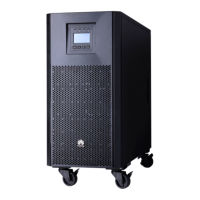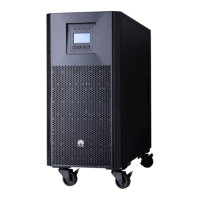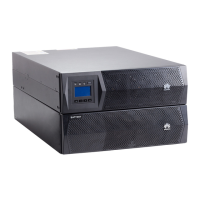Setting Key UPS Parameters
6.1
1. The 1 kVA UPS with standard backup time have two built-in batteries. The 2 kVA UPS with
standard backup time have four built-in batteries. The 3 kVA UPS with standard backup time
have six built-in batteries.
2. If the 1 kVA UPS with long backup time needs to connect to external battery strings, each battery
string must consist of three 12 V batteries connected in series. If the 2 kVA UPS with long backup
time needs to connect to external battery strings, each battery string must consist of six 12 V
batteries connected in series. If the 3 kVA UPS with long backup time needs to connect to
external battery strings, each battery string must consist of eight 12 V batteries connected in
series.
3. The output charge current of the UPS with long backup time is set to 4 A by default. The current can be
set to 1 A, 2 A, 4 A, or 6 A based on customer requirements before delivery. If the UPS needs to
connect to battery boxes or battery strings, the total battery capacity must exceed 18 Ah.
Otherwise, batteries may be damaged. If the capacity of external battery boxes or battery strings
to be connected exceeds 40 Ah, it is recommended that an external charger be purchased to
increase the charge current. If an external charger is not purchased, the charge time will be long.
4. For the UPS with standard backup time, the battery capacity has a fixed value of 9 Ah and the
charge current has a fixed value of 1 A. Set the battery capacity to the total capacity of all
batteries actually connected. Set the battery capacity for the long backup time model based on
site requirements. The default value is 18 Ah. For example, if eight batteries (9 Ah, 12 V) are
connected in series to form a battery string, and two of such battery strings are connected in
parallel and then to the UPS, set battery capacity to 18 Ah (9 Ah + 9 Ah). This parameter affects
the backup time calculation. Incorrect setting will cause incorrect display of the backup time on
the LCD.
5. When the battery box or battery is connected to the UPS with long backup time for the first time,
you must perform a battery self-check to confirm that the connection is normal. Perform a self-
check as follows: Hold down ON/MUTE on the front panel for 5 seconds for the UPS to transfer
to battery mode so that you can perform a shallow discharge test. The UPS automatically
transfers to normal mode 10 seconds later.
6. Charge the batteries used for the first time for 5 hours. Otherwise, the battery discharge time will
decrease.
1. In the preset mode, LCD will return to the main page with 30 seconds of no operation.
2. If the long backup time model is not connected to an external battery box, the buzzer keeps
buzzing.
3. The UPS performs a battery self-check automatically once a week. If batteries are faulty, an alarm
is generated.
If this is the initial startup, set system parameters such as output voltage, output frequency, and
battery parameters as required.
a) After power on the UPS, it enters standby mode. Hold down SELECT for 5 seconds to access the login
screen for parameter settings. The initial password is 001. After you have entered the correct password,
press OFF/ENTER to enter UPS setting mode and set parameters as required.
b) During the setting of UPS parameters, press ON/MUTE for more than 3 seconds. Release the button
when you hear a beep sound to select the previous option. During the setting of UPS parameters, press
SELECT for more than 3 seconds. Release the button when you hear a beep sound to select the next
option. Press OFF/ENTER for more than 3 seconds to confirm the setting. The meaning of LCD display
character see 7.1 Character Display Description in page 7. Set voltage level to 220 V, 230 V
(default), or 240 V. Set output frequency level to 50 Hz, 60 Hz, and AUT (default). The battery
capacity for the UPS with standard backup time cannot be changed. The default value of battery
capacity is 18 Ah for the UPS with long backup time, and the value can range from 18 Ah to 999
Ah.
6
For more parameters setting information, see the UPS2000-A-(1 kVA-3 kVA) User Manual.
